Single-frequency Lasers
Definition: lasers emitting radiation in a single resonator mode
More general term: narrow-linewidth lasers
German: einmodige Laser
How to cite the article; suggest additional literature
Author: Dr. Rüdiger Paschotta
A single-frequency laser (sometimes called a single-wavelength laser) is a laser which operates on a single resonator mode, so that it emits quasi-monochromatic radiation with a very small linewidth and low phase noise (see also: narrow-linewidth lasers). Because any mode distribution noise is eliminated, single-frequency lasers also have the potential to have very low intensity noise. In nearly all cases, the excited mode is a Gaussian mode, so that the output is diffraction limited.
Particularly in low-power single-frequency lasers such as laser diodes, there is some small amount of optical power in various resonator modes, even though one mode is clearly dominating. This is because such modes may be only slightly below the laser threshold, so that spontaneous emission can already generate some substantial power. The mode suppression ratio (MSR) is then defined as the power of the lasing mode divided by that in the next strongest mode. It can be optimized by making the laser resonator more frequency-selective.
Single-frequency lasers can be very sensitive to optical feedback. Even if less than a millionth of the output power is sent back to the laser, this may in some cases cause strongly increased phase noise and intensity noise or even chaotic multimode operation. Therefore, single-frequency lasers have to be carefully protected against any back-reflections, often using one or two Faraday isolators.
Types of Single-frequency Lasers
Details of the physics of single-frequency operation are discussed in the corresponding article; the present article discusses the most important types of single-frequency lasers, which differ very much in terms of output power, linewidth, wavelength, complexity and price:
- Some low-power laser diodes, in particular index-guided types, usually emit on a single mode. Stable single-mode operation is often achieved with distributed feedback lasers (DFB lasers) or distributed Bragg reflector lasers (DBR lasers). Typical linewidths are in the megahertz region (→ Schawlow–Townes linewidth, linewidth enhancement factor). Significantly smaller linewidths are possible e.g. by extending the resonator with a single-mode fiber containing a narrow-bandwidth fiber Bragg grating, or with external-cavity diode lasers.
- Special kinds of fiber lasers allow for single-frequency operation. Some of these are based on unidirectional ring laser designs, others have linear resonators and very short (highly doped) fibers. In any case, at least one fiber Bragg grating is usually used. Linear fiber lasers are sometimes realized as distributed feedback lasers. Very narrow linewidths of a few kilohertz can be achieved (particularly with devices having somewhat longer resonators), whereas output powers vary between a few milliwatts and several watts – in combination with a single-frequency fiber amplifier even more.
- Diode-pumped solid-state bulk lasers can be forced to operate on a single mode; this is often achieved with unidirectional ring laser designs, often with an intracavity filter, and sometimes with the twisted-mode technique. Output powers can reach the multi-watt level, and the linewidth can be as low as a few kilohertz.
- Vertical cavity surface-emitting lasers (VCSELs) have very short monolithic laser resonators, thus huge cavity mode spacings, and easily emit a few milliwatts on a single mode. The linewidth is at least a few megahertz, but the tuning range (without mode hops) can be very large.
- A helium–neon laser can easily emit a single frequency, if its laser resonator is made short enough (of the order of 20 cm), because the gain bandwidth is small.
Most single-frequency lasers operate continuously, but there are also Q-switched single-frequency lasers, which do not exhibit mode beating and thus exhibit very clean pulse shapes and low noise.
Methods for Higher Output Powers
For higher output powers, master oscillator power amplifier configurations are often used. An alternative with potentially lower laser noise is to use injection locking of a high-power laser with a single-frequency low-power seed laser.
Applications
Typical applications of single-frequency lasers occur in the areas of optical metrology (e.g. with fiber-optic sensors) and interferometry, optical data storage, high-resolution laser spectroscopy (e.g. LIDAR), and optical fiber communications. In some cases such as spectroscopy, the narrow spectral width of the output is directly important. In other cases, such as optical data storage, a low intensity noise is required, thus the absence of any mode beating noise.
Single-frequency sources are also attractive because they can be used for driving resonant enhancement cavities, e.g. for nonlinear frequency conversion, and for coherent beam combining. The latter technique is currently used to develop laser systems with very high output powers and good beam quality.
Suppliers
The RP Photonics Buyer's Guide contains 56 suppliers for single-frequency lasers. Among them:

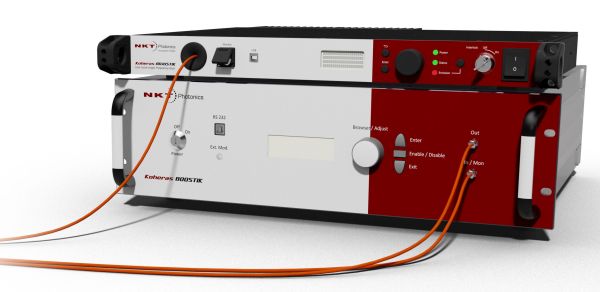
NKT Photonics
The Koheras narrow linewidth, single-frequency fiber lasers are ultra-low noise sources with longitudinal single mode and single frequency operation. The lasers are based on a DFB design ensuring robust and reliable operation and are delivered as fully integrated systems for industrial and scientific applications. Koheras offers an unprecedented low phase- and intensity noise level at Yb, Er and Tm wavelengths. It has a very high stability, and mode-hop free inherent single frequency output – even when exposed to changing environmental conditions. You can also get shot noise limited solutions for applications demanding an extra low intensity noise level.

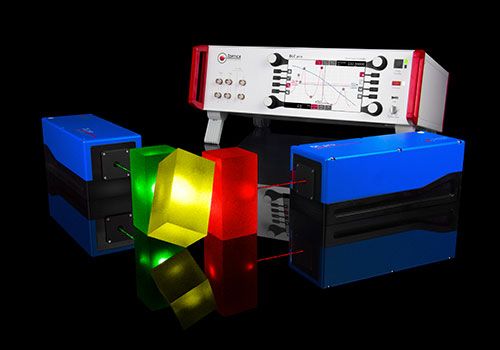
TOPTICA Photonics
All of TOPTICA’s tunable diode lasers offer a narrow linewidth of typically 100 kHz, corresponding to coherence lengths of almost 1 km. By stabilizing these lasers even further with TOPTICA’s locking electronics, linewidths below 1 Hz are possible.


OEwaves
The HI-Q™ Laser houses a proprietary driver/controller and the OEwaves laser source, which is based on a high quality factor (Q) Whispering Gallery Mode (WGM) micro-resonator. The laser is scalable to a variety of wavelengths in 370-–4500 nm.
The unique technology of the OEwaves HI-Q™ Laser leverages the self-injection on locking of a suitable commercially available laser diode via a resonant optical feedback from a high-Q WGM micro-resonator. Its monolithically integrated approach along with micro-scale mass and volume make the laser virtually insensitive to environmental vibrations .
Features:
- ultra-narrow instantaneous laser linewidth
- ultra-low phase/frequency noise
- 370–4500 nm wavelength
- low vibration sensitivity
- low residual amplitude modulation
- wavelength stability
- compact package
- integrated driver/controller
- USB or RS232 control interface
Applications:
- interferometric optical sensing
- LIDAR
- B-OTDR temperature and strain
- gas sensing
- optical metrology and spectroscopy
- acoustic sensing
- oil and gas exploration
- coherent communication
- test and measurement
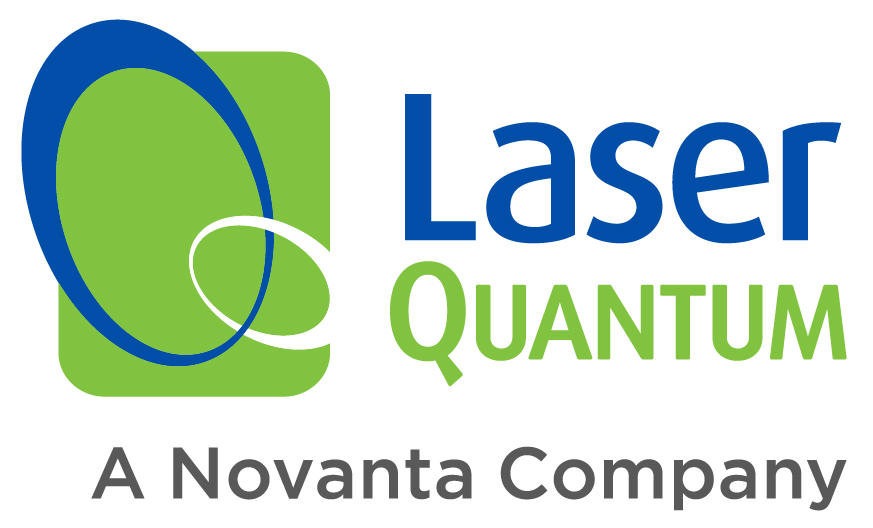

Laser Quantum
Laser Quantum manufacturers of torus mode-locked SLM lasers 532 and 660 nm lasers with active mode-locking to maintain a stable frequency output and output beam performance across long measurements and temperature fluctuations.


RPMC Lasers
RPMC offers a wide range of single frequency laser diodes and laser modules with wavelengths from 405 nm to 2 μm. These offerings include DFB and DBR diode lasers, external cavity VBG diode lasers, fiber lasers, and DPSS lasers. All are available in both OEM and turnkey packages.


Menlo Systems
Menlo Systems offers ultrastable, frequency stabilized lasers at basically any wavelength. We supply fully characterized systems with linewidths <1 Hz and Allan deviations of 2 × 10-15 (in 1 s) as well as modules and components allowing for state-of-the-art systems tailored to your requirements.


Lumibird
With the CVFL, CYFL and CEFL kilo models, Lumibird offers CW fiber lasers with very narrow linewidth down to 1 kHz. These single frequency lasers emits at 1054/1083 nm for the ytterbium version, in the 1.5-µm range for the erbium version and at frequency converted wavelengths for the CVFL model. These lasers are specifically designed for applications which requirehigh precision such as LIDAR, atomic spectroscopy, or atom cooling.
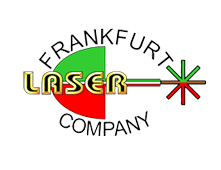
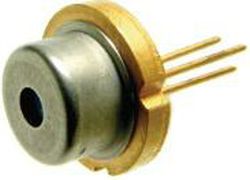
Frankfurt Laser Company
Frankfurt Laser Company offers various kinds of wavelength-stabilized laser diodes. Those based on DFB or DBR lasers exhibit single-frequency operation.
Questions and Comments from Users
Here you can submit questions and comments. As far as they get accepted by the author, they will appear above this paragraph together with the author’s answer. The author will decide on acceptance based on certain criteria. Essentially, the issue must be of sufficiently broad interest.
Please do not enter personal data here; we would otherwise delete it soon. (See also our privacy declaration.) If you wish to receive personal feedback or consultancy from the author, please contact him e.g. via e-mail.
By submitting the information, you give your consent to the potential publication of your inputs on our website according to our rules. (If you later retract your consent, we will delete those inputs.) As your inputs are first reviewed by the author, they may be published with some delay.
Bibliography
| [1] | M. Fleming and A. Mooradian, “Spectral characteristics of external-cavity controlled semiconductor lasers”, IEEE J. Quantum Electron. 17 (1), 44 (1981), doi:10.1109/JQE.1981.1070634 |
| [2] | K. Kobayashi and I. Mito, “Single frequency and tunable laser diodes”, IEEE J. Lightwave Technol. 6 (11), 1623 (1988), doi:10.1109/50.9978 |
| [3] | J. J. Zayhowski and A. Mooradian, “Single-frequency microchip Nd lasers”, Opt. Lett. 14 (1), 24 (1989), doi:10.1364/OL.14.000024 |
| [4] | J. J. Zayhowski, “Limits imposed by spatial hole burning on the single-mode operation of standing-wave laser cavities”, Opt. Lett. 15 (8), 431 (1990), doi:10.1364/OL.15.000431 |
| [5] | R. Paschotta et al., “Single-frequency ytterbium-doped fiber laser stabilized by spatial hole burning”, Opt. Lett. 22 (1), 40 (1997), doi:10.1364/OL.22.000040 |
| [6] | K. I. Martin et al., “Stable, high-power, single-frequency generation at 532 nm from a diode-bar-pumped Nd:YAG ring laser with an intracavity LBO frequency doubler”, Appl. Opt. 36 (18), 4149 (1997), doi:10.1364/AO.36.004149 |
| [7] | Y. Takushima et al., “Polarization-stable and single-frequency fiber lasers”, J. Lightwave Technol. 16 (4), 661 (1998), doi:10.1109/50.664080 |
| [8] | A. Liem et al., “100-W single-frequency master-oscillator fiber power amplifier”, Opt. Lett. 28 (17), 1537 (2003), doi:10.1364/OL.28.001537 |
| [9] | K. H. Ylä-Jarkko and A. B. Grudinin, “Performance limitations of high-power DFB fiber lasers”, IEEE Photon. Technol. Lett. 15 (2), 191 (2003), doi:10.1109/LPT.2002.806827 |
| [10] | A. Polynkin et al., “Single-frequency fiber ring laser with 1 W output power at 1.5 μm”, Opt. Express 13 (8), 3179 (2005), doi:10.1364/OPEX.13.003179 |
| [11] | S. Fu et al., “Review of recent progress on single-frequency fiber lasers”, J. Opt. Soc. Am. B 34 (3), A49 (2017), doi:10.1364/JOSAB.34.000A49 |
See also: single-frequency operation, single-mode operation, mode hopping, linewidth, narrow-linewidth lasers, distributed Bragg reflector lasers, laser diodes, fiber lasers, injection locking, twisted-mode technique, stabilization of lasers, fiber-optic sensors
and other articles in the category lasers
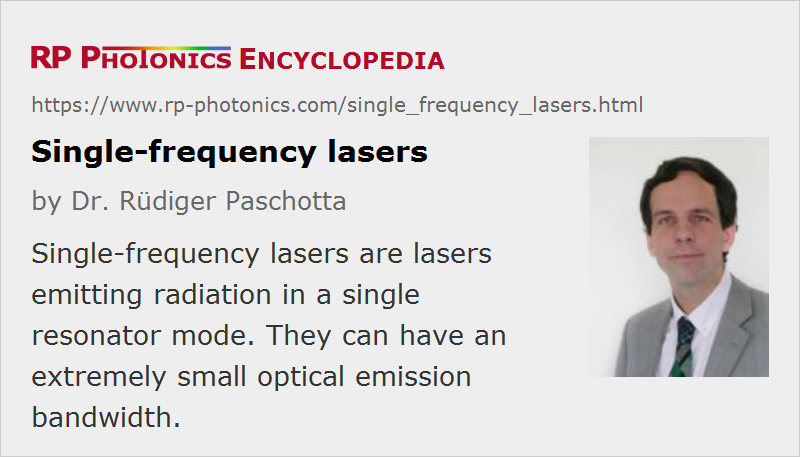 |




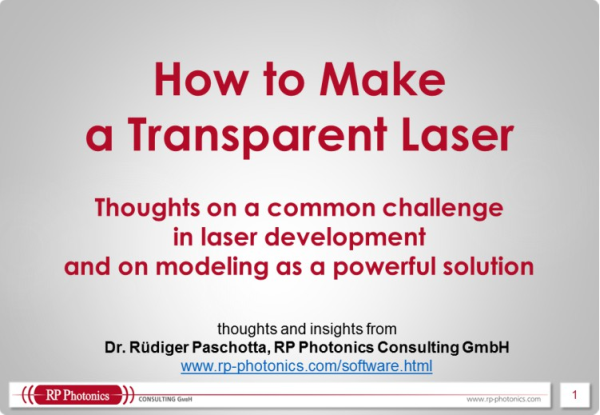
If you like this page, please share the link with your friends and colleagues, e.g. via social media:
These sharing buttons are implemented in a privacy-friendly way!